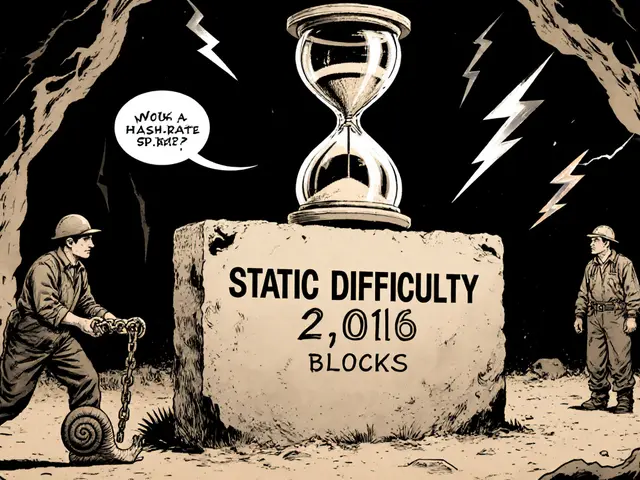
Crypto Money Laundering Sentencing Calculator
Estimate Potential Sentence
Enter details below to calculate estimated prison time based on federal sentencing guidelines.
Estimated Sentence
Key Statutes and Penalties
| Statute | Core Element | Max Prison Term |
|---|---|---|
| 18 U.S.C. § 1956 | Transferring proceeds of unlawful activity | 20 years per count |
| 18 U.S.C. § 1957 | Attempted laundering or conspiracy | 10 years per count |
| Bank Secrecy Act violations | Failure to file SARs, maintain AML program | 5 years per violation |
| Unlicensed money-transmitter | Operating without state/federal charter | 20 years (if tied to money-laundering) |
When prosecutors bring cryptocurrency money laundering the illegal movement of digital assets to hide their criminal origin into federal court, the penalties can reach the maximum of 20 years behind bars. Over the past few years, the U.S. government has sharpened its focus on crypto‑related financial crimes, and the sentencing landscape has evolved fast enough that many people still wonder what the real risk looks like.
TL;DR
- Federal statutes allow up to 20 years per count for money‑laundering offenses involving crypto.
- Sentences depend on the amount laundered, the defendant’s role, and any aggravating factors.
- High‑profile cases like the Kais Mohammad prosecution show a range from 2 years to potentially double‑digit terms.
- Stablecoins and mixers increase detection difficulty, prompting harsher penalties.
- Defendants can shave time by cooperating, but the DOJ is pushing for deterrent sentences.
Why Crypto Attracts Money‑Laundering Scrutiny
The appeal is simple: digital tokens can move across borders in seconds, often without a traditional bank’s paperwork. FinCEN the Financial Crimes Enforcement Network has labeled cryptocurrency a “high‑risk” channel for illicit finance since 2020, and every year the agency publishes more enforcement actions. In the first half of 2025 alone, thieves stole more than $2.17billion from crypto services - a 17% jump from 2022 - and the numbers keep climbing.
Legal Foundations: The Statutes Behind the Charges
Most crypto‑laundering cases sit on a stack of federal laws:
- Bank Secrecy Act requires financial institutions, including crypto exchangers, to report suspicious activity (18U.S.C.§326).
- 18U.S.C.§1956 covers money‑laundering through the use of proceeds of unlawful activity, allowing up to 20 years per count.
- 18U.S.C.§1957 targets attempts to launder money, with a maximum of 10 years per count.
- State‑level money‑transmitter licensing laws, which can add charges for operating without a charter.
When a defendant is charged under several of these statutes, the sentences can stack, quickly approaching the theoretical 20‑year ceiling.
How Sentencing Guidelines Translate to Real Prison Time
Federal sentencing guidelines look at three core factors:
- Amount of illicit funds - larger sums trigger higher offense levels.
- Defendant’s role - organizers face a multiplier, while low‑level couriers may get a reduction.
- Prior history and aggravating circumstances - repeat offenders, use of sophisticated mixing services, or international conspiracies add points.
Take the Kais Mohammad known online as ‘Superman29’ case. He ran an unlicensed crypto‑money‑service that moved roughly $25million from 2014‑2019, charging up to 25% commissions. He pleaded to operating an illegal money‑transmitting business and money‑laundering and received 24 months in prison. The relatively short term reflected a plea deal and his cooperation with investigators.
Contrast that with a 2024 racketeering indictment involving $150million in Bitcoin moved through multiple mixers and foreign exchanges. The lead conspirator was sentenced to 15 years under §1956, plus an additional 5 years for a separate drug‑trafficking count, illustrating how multi‑charge stacks can surge toward the 20‑year limit.

Emerging Trends: Stablecoins, Mixers, and Cross‑Border Schemes
Stablecoins such as Tether (USDT) a dollar‑pegged token used for rapid transfers have become the preferred vehicle for laundering because they combine the speed of crypto with the price stability of fiat. The DOJ’s 2025 briefing noted that stablecoins reduced the need to convert back to cash, making it harder for traditional AML systems to flag suspicious spikes.
Mixers-services that shuffle coins through a pool to obscure origins-have also matured. The Czech government’s March 2025 Bitcoin scandal uncovered a chain that moved 468BTC to a hardware wallet, then split the amount into four separate transfers and an extra 151BTC. Investigators traced the flow through Kraken a major cryptocurrency exchange and several privacy‑focused mixers before the assets vanished into offshore wallets.
Cross‑border operations are now the top emerging threat according to the EU’s Anti‑Money‑Laundering Authority (AMLA) the EU watchdog for financial crime. Their reports highlight how a single fraud ring can operate from three continents, swapping Bitcoin for Tether, then funneling the funds through Asian exchanges that have limited reporting obligations.
Comparison of Key Statutes and Maximum Penalties
| Statute | Core Element | Max Prison Term |
|---|---|---|
| 18U.S.C.§1956 | Transferring proceeds of unlawful activity | 20 years per count |
| 18U.S.C.§1957 | Attempted laundering or conspiracy | 10 years per count |
| Bank Secrecy Act violations | Failure to file SARs, maintain AML program | 5 years per violation |
| Unlicensed money‑transmitter | Operating without state/federal charter | 20 years (if tied to money‑laundering) |
Defense Strategies and What They Mean for Sentencing
Defendants often attack the technical side of the case. They may argue that blockchain analysis is too ambiguous to prove ownership, or they claim that the crypto activity was a legitimate business. Expert witnesses-both for the prosecution and defense-spend weeks dissecting transaction graphs, mixer logs, and wallet fingerprints.
Cooperation can shave years off a sentence. In the Mohammad case, the 24‑month term was largely a result of his agreement to provide intel on other operators. However, the DOJ’s 2025 policy memo stresses that cooperation will only offset sentences when the help substantially disrupts an ongoing criminal enterprise.
In practice, a defendant who can demonstrate that they maintained a robust AML program, filed all required SARs, and acted in good faith may see a guideline reduction of 4‑6 months. Conversely, if the court finds that the defendant used advanced mixers or knowingly facilitated sanctions‑evading transfers, the judge can impose a guideline increase that pushes the term close to the statutory maximum.
Future Outlook: Toward Even Harsher Penalties?
The projected $51billion in illicit crypto volume for 2025 is set to fuel new legislative proposals. Lawmakers are pushing for mandatory minimums of 10 years for any crypto‑laundering scheme that exceeds $10million in value. If such measures pass, the current “up‑to‑20‑year” ceiling will become a floor for the biggest cases.
International coordination is also tightening. The United Nations Office on Drugs and Crime (UNODC) is drafting a cross‑border AML framework that would allow simultaneous prosecutions in multiple jurisdictions, potentially adding concurrent sentences that stack in practice.
In short, the risk landscape is getting steeper. While a 24‑month sentence may have seemed typical a few years ago, newer cases show that a $100million laundering operation can land a defendant in prison for 18‑20 years.
Frequently Asked Questions
What is the maximum prison time for crypto money laundering?
Under 18U.S.C.§1956, a defendant can receive up to 20 years for each count of money laundering involving cryptocurrency.
How do stablecoins affect sentencing?
Stablecoins speed up transfers and hide the origin of funds, which prosecutors argue shows a higher level of sophistication. Courts often treat stablecoin‑based schemes as aggravating factors, leading to longer sentences.
Can cooperation reduce a crypto laundering sentence?
Yes, if a defendant provides substantial assistance that helps dismantle a wider network, judges may grant a downward departure from the guideline range, sometimes shaving years off the term.
What role do mixers play in prosecutions?
Mixers obscure transaction trails, making it harder for investigators to link coins to a defendant. When a court finds that a mixer was deliberately used to evade detection, it usually adds a sentencing enhancement.
Are there any recent legislative changes?
Congress is debating mandatory minimums for crypto‑laundering exceeding $10million. If enacted, the baseline sentence could be 10 years, with additional years added for each count.






There are 14 Comments
Alie Thompson
It is profoundly disturbing that a technology once heralded as a beacon of decentralized freedom has become a conduit for the most reprehensible forms of exploitation, namely money laundering that preys on the vulnerable and fuels organized crime. The ethical void evident in the schemers' blatant disregard for the rule of law underscores a fundamental moral decay that cannot be excused by arguments of anonymity or innovation. When prosecutors pursue 20‑year sentences, they are not merely doling out punishment; they are affirming society's collective commitment to justice and the protection of the innocent. Every blockchain transaction that obscures illicit proceeds erodes public trust, and the resultant erosion empowers predators to further entrench their power. It is incumbent upon every citizen to denounce such conduct as an affront to the common good, and to demand that legislators fortify AML frameworks to close loopholes exploited by bad actors. Moreover, the use of stablecoins and mixers represents a calculated escalation of deceit, revealing a sophisticated intent to evade detection, which must be met with proportionate legal severity. The courtroom should become a crucible where the moral calculus tilts decisively against those who would weaponize technology for nefarious ends. In this vein, long‑term incarceration serves a dual purpose: deterrence and the affirmation of societal values that prioritize transparency and accountability. The stakes are far too high to allow leniency, as any concession may embolden future conspiracies that distort the financial ecosystem. Ultimately, the pursuit of justice in crypto money‑laundering cases is not a battle against a technology, but a stand against the exploitation of humanity for profit. By imposing maximum penalties where appropriate, the justice system reasserts its role as the guardian of ethical order. The narrative must shift from vilifying blockchain itself to targeting the malicious intent behind its misuse, thereby preserving the technology’s potential for good while safeguarding public welfare. The legal community, regulators, and the public must unite in this moral crusade, rejecting any excuse that normalizes criminal conduct under the guise of innovation. Only through unwavering resolve can we hope to restore integrity to our financial institutions and protect the social fabric from corrosive criminal enterprises. The message is clear: illegal laundering of cryptocurrency will be met with the full weight of the law, and no amount of technical wizardry can shield transgressors from accountability.
Samuel Wilson
Thank you for outlining the gravity of the situation so comprehensively. The legislative response must indeed reflect the seriousness of these offenses. By adhering to the sentencing guidelines, courts ensure proportionality and fairness. Continued cooperation between regulators and law enforcement will be essential moving forward.
Rae Harris
While the moral framing is potent, let's not forget that the technical architecture of mixers introduces a level of privacy that is fundamentally different from traditional banking obfuscation. In crypto parlance, the use of a "tumbling service" amplifies transaction anonymity sets, which complicates forensic linkage. Thus, asserting a blanket condemnation without addressing the underlying cryptographic primitives risks oversimplification. Nonetheless, the policy implications remain significant, especially when layering cross‑chain bridges into the mix.
Danny Locher
It's sad to see how these crimes affect everyday folks, but there's still hope. If people stay informed and demand stronger AML rules, we can make a difference. Together we can push for a safer crypto space.
Emily Pelton
Indeed, the community must rally-exercise vigilance, demand transparency, and support robust compliance frameworks, all while fostering education, fostering empowerment, and encouraging responsible innovation!!!
sandi khardani
The data presented in the article is a textbook example of how the crypto industry consistently bypasses regulatory scrutiny by exploiting technical loopholes. Every time a new mixer emerges, developers tout "privacy" while knowingly facilitating illicit pipelines. The DOJ's aggressive stance is justified, yet the industry continues to chase the next anonymization protocol, effectively turning a blind eye to the criminals who profit from these tools. Moreover, the narrative that stablecoins are merely "convenient" overlooks the reality that they provide a stable conduit for moving large sums without triggering the volatility alerts that might draw attention. It's evident that the market's demand for untraceable transactions fuels a shadow economy that undermines the entire financial system. When you consider the sheer volume of hacks-billions siphoned in the past few years-the pattern is unmistakable: the same actors repeatedly reappear, merely swapping platforms to evade detection. This cyclic behavior demonstrates a systemic failure to hold perpetrators accountable, which only emboldens further abuse. The legal framework, though robust on paper, is hamstrung by jurisdictional challenges and the rapid pace of technological evolution. Consequently, legislators must act decisively, tightening definitions and closing gaps before the next wave of sophisticated laundering schemes rolls out. In short, the crypto space's current trajectory mirrors a wild west where the outlaws wield code as their weapon, and the only viable solution lies in coordinated, international enforcement paired with stringent compliance mandates.
Donald Barrett
The analysis is spot‑on. The lack of accountability is intolerable.
Christina Norberto
One must ponder whether the relentless pursuit of crypto laundering statutes is not, in fact, a grand stratagem orchestrated by shadowy cabals to consolidate power over nascent financial ecosystems. The very architecture of decentralized ledgers could be co‑opted by clandestine entities seeking to manipulate punitive mechanisms for geopolitical leverage. Consider the possibility that certain high‑ranking officials, operating behind veils of secrecy, deliberately accentuate the narrative of criminality to justify expansive surveillance regimes. Such machinations, if true, would render the legal edicts less a shield for the public and more a scalpel for control. Nonetheless, the superficial veneer of justice continues to be sold to the masses as a necessary bulwark against anarchic malfeasance, thereby obscuring deeper conspiratorial currents that may be at play.
Fiona Chow
Ah, the classic conspiracy routine-because obviously every lawmaker is part of a secret cabal, right? While the drama is entertaining, the tangible harm caused by actual laundering operations shouldn't be dismissed as mere theater.
Millsaps Delaine
When one surveys the corpus of legal literature surrounding crypto money‑laundering, it becomes increasingly apparent that the epistemological foundations of our punitive frameworks are, at best, tenuously constructed. The prevailing discourse, replete with hyperbolic pronouncements, often neglects the nuanced interplay between technological innovation and jurisprudential adaptation. In effect, the legislative apparatus attempts to retroactively graft archaic statutes onto a dynamic digital substrate, resulting in a dissonant symphony of red‑tape and unintended consequences. This discord is further amplified by the ostentatious pretensions of certain policymakers who, in their zeal, profess to possess an ontological mastery over cryptographic mechanisms-a claim that is both audacious and fundamentally flawed. Moreover, the relentless chase for imposing draconian sentences overlooks the potential for restorative justice models that could harmonize deterrence with rehabilitation. One must therefore advocate for a more sagacious, interdisciplinary approach that integrates economic theory, cryptographic expertise, and ethical philosophy, lest we perpetuate a cycle of punitive excess that ultimately erodes the very social contract it purports to defend.
Ayaz Mudarris
Indeed, the synthesis of economic incentives and legal deterrence must be calibrated with precision. By invoking a multidisciplinary framework-drawing upon philosophy, economics, and cryptography-we can engender policies that are both just and effective. This approach not only mitigates the risk of over‑penalization but also fosters a culture of compliance rooted in understanding rather than fear. Ultimately, it is through such enlightened governance that the crypto ecosystem can mature responsibly.
Irene Tien MD MSc
It's fascinating, really, how the very tools designed to democratize finance have been hijacked by shadowy operatives who view anonymity as a ticket to impunity. The kaleidoscopic swirl of mixers, stablecoins, and offshore exchanges creates a dazzling illusion of untouchability, yet every shimmer is merely a smokescreen for criminality. One could argue that the regulatory response is a desperate attempt to tame a beast that thrives on chaos, but perhaps the beast is being fed by the very fear it provokes. In any case, the narrative that "crypto is the wild west" ignores the sophisticated forensic techniques now employed by law enforcement-techniques that can piece together even the most obfuscated transaction graphs. So, while the drama of "digital outlaws" captures public imagination, the reality is far more prosaic: a relentless cat‑and‑mouse game where each side constantly upgrades its arsenal. Ultimately, the outcome hinges not on punitive zeal alone, but on a balanced blend of technological literacy, regulatory foresight, and a collective willingness to confront uncomfortable truths about power and profit.
kishan kumar
Indeed-technology evolves, and so must our frameworks. 😊 The challenge lies in achieving equilibrium between innovation and oversight, ensuring that progress does not become a veil for illicit gain.
Anthony R
Thank you all for the thoughtful contributions; they greatly enrich the discussion, and highlight the multifaceted nature of this complex issue.
Write a comment
Your email address will not be published. Required fields are marked *